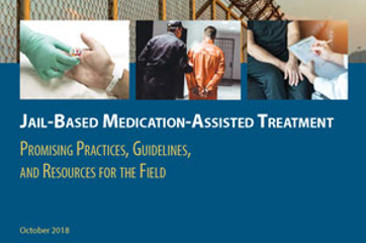|
|
| MAT: What's In It For Me? |
| By National Commission on Correctional Health Care |
| Published: 11/12/2018 |
 The National Commission on Correctional Health Care and the National Sheriffs’ Association have produced a new resource for sheriffs and jail administrators. Jail-Based Medication-Assisted Treatment: Promising Practices, Guidelines, and Resources for the Field guides jails in developing effective MAT programs for the treatment of people with opioid use disorders. The following is an excerpt from the report, courtesy NCCHC and NCA. For a copy of the complete report, go to http://www.ncchc.org/jail-based-MAT or call 773-880-1460.
The National Commission on Correctional Health Care and the National Sheriffs’ Association have produced a new resource for sheriffs and jail administrators. Jail-Based Medication-Assisted Treatment: Promising Practices, Guidelines, and Resources for the Field guides jails in developing effective MAT programs for the treatment of people with opioid use disorders. The following is an excerpt from the report, courtesy NCCHC and NCA. For a copy of the complete report, go to http://www.ncchc.org/jail-based-MAT or call 773-880-1460.
MAT: What’s In It for Me as a Criminal Justice Executive? Medication-assisted treatment (MAT), utilizing the U.S. Food and Drug Administration (FDA)-approved medications methadone, buprenorphine, or naltrexone, is considered a central component of the contemporary standard of care for the treatment of individuals with opioid use disorders (OUDs). It may also be used for individuals with co-occurring mental illnesses, in consultation with a physician. Evidence strongly supports that the use of MAT increases the likelihood of successful treatment for individuals with OUDs and reduces morbidity and mortality. Research has begun to show that adding MAT to the treatment of those involved in the criminal justice system confers the same benefits and also reduces recidivism. These findings are particularly relevant for criminal justice decision makers—including sheriffs and corrections department officials—given that Bureau of Justice Statistics surveys found that nearly two-thirds (63 percent) of people in jail meet criteria for drug dependence or abuse. Many of these individuals have OUDs and could benefit from access to MAT, a combination of behavioral interventions and medications that have been shown to decrease opioid use, increase treatment retention, reduce overdose, and reduce criminal activity. By thoughtfully and carefully including MAT, when appropriate, as a tool in the range of jail-based treatment options, the value proposition to criminal justice executives may include:
However, as of January 2018, 20 state DOCs did not offer MAT in their drug treatment programs for incarcerated individuals beyond limited methadone maintenance for pregnant women. Out of several thousand local and county jails, fewer than 200 in 30 states provide MAT, and the protocol is primarily limited to the provision of injected naltrexone immediately before individuals are released back into the community. Jails that provide MAT for pregnant women typically discontinue it postpartum, although this is not the recommended standard of medical care. To download Jail-Based Medication-Assisted Treatment: Promising Practices, Guidelines, and Resources for the Field, go to www.ncchc.org/jail-based-MAT or call 773-880-1460. |
Comments:
Login to let us know what you think
MARKETPLACE search vendors | advanced search

IN CASE YOU MISSED IT
|


Thanks for sharing this valuable information this really help me a lot. Great Post. spotify premium free tinytunes apk download gtunes free download